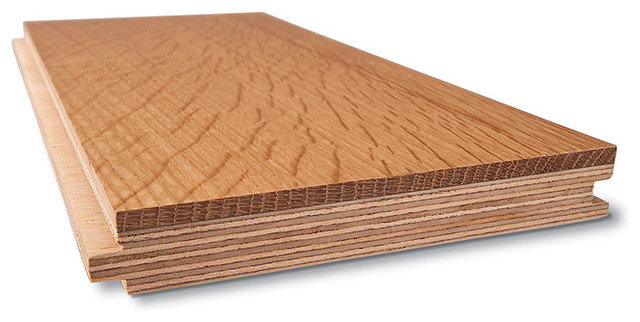This photo shows a cross section of a high-quality, engineered wood floor. They range in thickness from 3/8" to 3/4" (that's approximately 1 cm to 2 cm). The top layer is a veneer of the desired wood; the thicker that veneer is, the more expensive the floor will be.
When this top veneer is very thin (.6mm or so) the resulting floor cannot be refinished should that ever be needed. However, when the top veneer is between 2 mm and 6 mm, it can be refinished multiple times.
The layers in the buildup underneath the veneer top layer are important and also play a role in the final price. There can be anywhere between three and 12 layers of plywood and unfinished white wood, depending on the thickness and quality of the finished product.
When you are shopping for an engineered wood floor, pay attention to how it's made inside almost as much as you pay attention to how the top layer looks.
The different thicknesses exist so engineered wood flooring can be used in a variety of applications without awkward transitions between different flooring materials.
The most common transitions people have trouble bridging are areas between a tile kitchen or bath floor and the rest of the house. By using an engineered wood floor in a renovation, you can remove the need for large transition strips and trimming down doors.
Engineered wood floors were developed for use over concrete slabs, but the thicker, 3/4"-thick (2 cm) versions can be nailed down over a wood subfloor, the same way you would install a plank floor.
If you can save some money when you're building or renovating a frame house by buying a quality engineered wood floor, go for it. No one will know but you. Nailing down any wood floor is a job best left to the pros. Seriously.
Engineered wood floors thinner than 3/4" (2 cm) can be glued down, similar to how you'd glue down a vinyl or resilient floor. Gluing down an engineered wood floor is a project a do-it-yourselfer can usually take on provided he or she has a lot of time and a fair amount of experience with DIY projects. It may make more sense to have it installed, but there's a ton of information out there for the motivated.
The newest, thinnest engineered floors use an advanced tongue-and-groove system that locks them in place. These thin floors (usually called floating floors) can be placed over a cork underlayment or directly over an older floor.
Though it does take some skill, floating floors are the easiest to install. But before you attempt to do this on your own, be sure you have access to a table saw and chop saw — and know how to use them.
An engineered wood floor will last from 20 to 100 years, depending on the thickness of of the top veneer. The best engineered wood floors available will last as long and perform as well as a plank floor, so another consideration to keep in mind is how long you want this material to last.
Using a high-quality, long-lasting engineered wood floor won't affect your resale value, but using a cheap one will.
The characteristics of the wood that ends up on the top layer will always play into the longevity and resilience of an engineered wood floor, though the effect is moderated somewhat. Even so, a Brazilian Cherry engineered wood floor will always hold up to more than a North American walnut floor will. Choosing an engineered option you may save money and end up with a more stable and adaptable flooring solution.
Engineered wood floors
Pros: Can be used in places wood plank floors can't be used; can be a more sustainable option; tend to cost less than solid planks.
Cons: Cheap versions of this product won't last very long. Beware of low prices.
Suggested uses: Anywhere you'd use a plank floor, plus above- and below-grade locations.


No comments:
Post a Comment